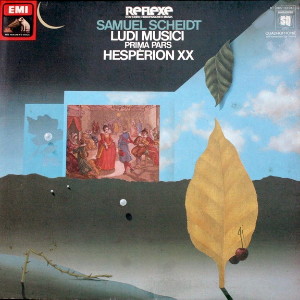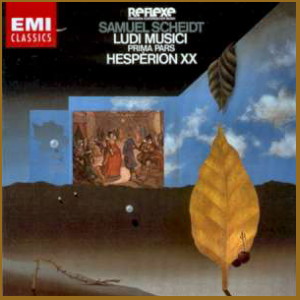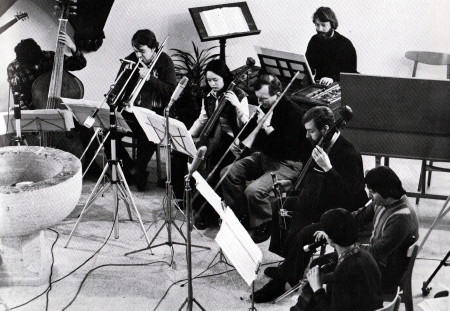 |
1 LP -
1C 065-30 943 Q - (p) 1978
|

|
| 1 CD - 8
26512 2 - (c) 2000 |
 |
| 1 CD -
CDM 7 63067 2 - (c) 1989 |
|
| SAMUEL SCHEIDT (1587-1654) -
Ludi Musici (Prima Pars) |
|
|
|
|
|
| Paduana,
Galiarda, Courante, Alemande, Intrada,
Canzonetto, ut vocant, quaternis &
quinis vocibus, in gratiam Musices
studiosorum, potissimum Violistarum
concinnata unà cum Basso Continuo.
Hamburgi Anno M. DC XXI |
|
|
| - Intrada
(XXIII) a 5 - Bläser,
Viole da gamba, Cembalo, Theorbe,
Trommel, Tambourin |
4' 10" |
|
| - Paduan (V) a 4
- Viole da gamba, Cembalo |
5' 12" |
|
| - Galliard
(XXIV) a 4 - 2 Flöten,
Viole da gamba, Cembalo |
1' 36" |
|
| -
Courant (XVII) a 4 - Viole
da gamba, Cembalo |
1' 35" |
|
| -
Paduan (VI) a 4 - Viole
da gamba, Bläser, Orgelpositiv |
5'
12"
|
|
| - Galliard
Battaglia (XXI) a 5 - Bläser,
Viole da gamba, Orgelpositiv,
Gitarre |
4' 09" |
|
| -
Alamande (XVI) a 4 - Viole
da gamba, Cembalo |
1' 36" |
|
| -
Canzon ad imitationem Bergamasca
Anglica (XXVI) a 5 - Bläser,
Viole da gamba, Orgelpositiv,
Theorbe |
5' 09" |
|
|
|
|
| - Canzon super
"O Nachbar Roland" (XXVIII) a 5
- Viole da gamba, Cembalo, Laute |
6' 09" |
|
| - Courant (XI) a
4 - Flöte, Viole da gamba,
Gitarre |
1' 25" |
|
| - Courant
(XIII) a 4 - Viole da
gamba |
1' 25" |
|
| - Canzon Cornetto (XVIII) a
4 - 2 Zinken, 2 Sopran-Viole da
gamba, Cembalo |
3' 18" |
|
| -
Paduan (III) a 4 - Bläser,
Orgelpositiv, Violone |
4' 23" |
|
| -
Galliard (XXV) a 5 - Viole
da gamba, Bläser, Violone,
Cembalo, Laute |
3' 10" |
|
| -
Courant (XVII) a 4 - 2
Flöten, Viole da gamba, Cembalo |
1' 43" |
|
| -
Canzon super "Cantionem Gallicam"
(XXIX) a 5 - Viole da
gamba, Bläser, Orgelpositiv, Laute |
5' 13" |
|
|
|
|
| HESPÈRION XX |
|
| -
Jordi Savall, Diskantgambe |
|
| -
Christophe Coin, Diskant- und
Altgambe |
|
| -
Ariane Maurette, Tenorgambe |
|
| -
Masako Hirao, Sergi Casademunt,
Roberto Gini, Baßgambe |
|
| -
Pere Ros, Violone |
|
| -
Bruce Dickey, Jean-Pierre Canihac, Zink |
|
| -
Jean-Pierre Mathieu, Alt- und
Tenorposaune |
|
| -
Charles Toet, Tenorposaune |
|
| -
Richard Lister, Baßposaune |
|
| -
Jeanette van Wingerden, Sopran-
und Altblockflöte |
|
| -
Lorenzo Alpert, Gabriel Garrido, Sopranblockflöte |
|
| -
Colin Tilney, Clavicembalo und
Orgelpositiv |
|
| -
Hopkinson Smith, Laute, Gitarre
und Theorbe |
|
|
|
|
|
Luogo
e data di registrazione |
|
Evangelische
Kirche, Séon (Svizzera) - 21-24
febbraio 1978 |
|
|
Registrazione: live /
studio |
|
studio |
|
|
Producer / Engineer |
|
Gerd
Berg / Johann-Nikolaus Matthes
|
|
|
Prima Edizione LP |
|
EMI
Electrola "Reflexe" - 1C 065-30
943 Q - (1 lp) - durata 57' 07" -
(p) 1978 - Analogico
(Quadraphonic) |
|
|
Prima Edizione CD |
|
EMI
"Classics" - CDM 7 63067 2 - (1
cd) - durata 57' 07" - (c) 1989 -
ADD |
|
|
Edizione CD |
|
EMI
"Classics" - 8 26512 2 - (1 cd) -
durata 57' 03" - (c) 2000 - ADD |
|
|
Note |
|
- |
|
|
|
|
|
 SAMUEL
SCHEIDT SAMUEL
SCHEIDT
In
1620, Markgraf Christian
Wilhelm von Brandenburg,
administrator ot the
Archbishopric of Magdeburg in
Halle, appointed his court
organist Samuel Scheidt
(1587-1654) to the post of
director of music at court.
Soon afterwards Scheidt
published a collection of
instrumental pieces, since
“some of them have been
brought out in secret and
against my wishes”, those
pieces moreover having been
altered. The printed edition
contains 32 pieces of richly
imaginative instrumental
music. In
the years 1622, 1625 and 1627
Scheidt published further
volumes of the official
repertoire of the court
chamber orchestra, this music
now being known as Ludi
musici (musical
games). Unfortunately, with
the exception of one of the
basso continuo
voices, this music has
disappeared. Each piece in
the first volume is
dedicated to a musical
friend at the court or to
one of the court orchestral
musicians. The order, style
and tonality of the music in
Scheidt’s collection is only
to be fully understood in
the light of the strong
influence of English
instrumental music, namely
that ofthe English Consort.
He himself hinted at this
influence in the title of
No. 26, Canzon Bergam.(asca)
Angl.(ica)
and this same influence can
be seen quite clearly in
other pieces. The Markgraf
was related through the Duke
of Braunschweig to the
English King, James 1st.
The famous English virtuoso
viola player William Brade
visited Halle in 1618. The
title of Scheidt’s work
which rather clumsily lists
the varied contents is
similar to a large extent to
that of Brade: New,
selected Pavanes,
Galliards, Canzonas,
Allemandes and Courantes
(1609), and also to that of
the English composer Thomas
Simpson: An opus of new
Pavanes, Galliards, Intradas,
Canzonas... Allemandes,
Courantes (1617).
Simpson was a viola player
in Copenhagen in the court
orchestra of the Danish king
who was an uncle of the
Regent in Halle. Scheidt’s
collection was published by
Michael Hering in Hamburg,
as had been the works of
Brade and Simpson.
The Ludi musici
contain two kinds of music:
dance pieces and free
instrumental pieces. The
dances, as they are listed
in the title: Pavanes
(6), Galliards (5),
Courantes (10) and Allemandes
(3), are arranged in
consecutive groups. Scheidt
does not arrange them in the
cyclic form of a Suite, as
does Brade in 1609, or his
Leipzig friend Johann
Hermann Schein in 1617 in Banchetto
musicale. He even
ignores the conventional
practice of varying the
material of the Pavane
to form the ensuing Galliard
which is its partner. The
variation on a model
movement was used by
Scheidt, but usually in
dances of a similar type:
take, for example, the Courante
No. 17, of which the
variation, No.32 (ad
imitationem Courant 17)
forms the end of the work. A
further example is the Galliard
No. 24 which is a
five-part version of the
four-part Galliard No. 7.
The different, highly
artistic design of the
individual dance movements
by Scheidt reflects the
stage of development of
dance music and concert
music. The Allemande and the
Courante have only two
repeated parts, and these
parts in themselves show
little musical development.
The Allemande has the
character of a functional
dance-piece
through its song-like melody
and clear 4
and 8-bar phrases; on the
other hand the increasingly
polyphonic nature of the
second half is evidence of
the English characterisation
of this dance which contrasts
with the compact, plain form
of the German type which is
simply called Dantz.
The old French court dance Courante,
which was first introduced
into Europe around 1600, and
which was characterised by its
buoyant 3/4 or 6/4 time, has
similar dance-like features,
for example, in the five-part
No.23, where short melodic
parts are linked tonally by
means of a second high part
written a third below the
first part. For the most part
the Galliards retain their
rhythmically profiled, 3/4
time, dancelike character,
full of courtly grace. All three
parts of No. 25 have the even
phrasing of 16 bars which
corresponds with
dance-figures. In No.24, the
dance rhythm is also
emphasised by, for example,
repeated notes, however, the
plain melodic phrases of the
model (No. 7) are transformed
into virtuoso figures and
divided in alternating fashion
between two high solo parts.
This alternating between parts
is expanded in the third
section of the Galliard No. 25
to achieve the effect of two
juxtaposed instrumental
forces, over the fundamental
structure of a diatonically
ascending bass part. In No. 21
the alternating use of two
instrumental groups is
exploited programmatically in
a Galliard Battaglia.
The close succession of one
motif upon another, their
rivalry and final union in
excited momentum bears witness
to the genre of “musical
battle” which had been so
popular since Janequin’s
chanson La Bataille
(1530), The work Battle
Galliard by John Dowland
(1604), dedicated to the
Danish king, was the direct
model for Scheidt’s work which
is typical in its ideas, with
rhythmically emphasized
repetitive notes, slow-moving
harmony and fanfare-like
motifs, Scheidt took Dowland’s
original thematic concept in Battle
Galliard and expanded it
fourfold in his own work. He
also rewrote it for Clavier
under the title Galliard
Dulenti variirt.
The process of stylisation
which can also be observed in
the other dance movements
reaches a final stage in the
Pavanes which open Scheidt’s
collection. The framework of
dance music is finally broken.
Serious and solemn in
expression, intricate and
tightly woven, built in three
larger parts, they follow the
type of the English Pavane,
as V. Haussmann explicitly
called them in 1604. They can
only be called Pavanes in so
far as they are characer
pieces. Otherwise they already
breathe the spirit of the free
instrumental canzone. This is
shown, for example, in the
homogeneous thematic material
moving in seconds in the
manner of the old classical
vocal polyphony at the
beginning of Nos. 3 and 5, or
in the constructive conception
of the bass in the lamentoso
steps in chromatic fourths in
No.5 (Part II).
The cantus-firmus type octave
passage in No.6 (Part III)
reminds us, when it transfers
to the upper voice, of
Monteverdi's Sonata
sopra Sancta Maria
(1610). Thus the Pavanes, with
their intricately constructed
voices, their imitation and
filigree work present an
example of the highly
developed English chamber
music of the Consorts.
In
spite of the fact that Scheidt
did not put the single
five-part Intrada (No.
22) at the beginning, it
preserves, beyond its possible
function as a processional
march, the character of a
festive opening music in C
major. Scheidt’s work
anticipates the duo
concertante sonata form which
was composed, for instance, by
the Vienna Director of Court
Music, J.H.Schmelzer, around
1660. In the 2nd part two
soloists compete in three-part
chord figures derived from the
wind motifs which are extended
in Part III
also to a bass part. This
baroque trio form is
accompanied by standing notes
on the other instruments. Thus
the Intrada could
also be performed without the
continuo part as open-air
music. The Intrada has
an additional section in the
more lively 6/4 time. This was
derived from the habit of
dance musicians of playing
improvised versions of 2/4
dances in three time. The Pavane
No. 3, for instance, has
such a Nachtanz (added
dance) in the so-called Proportion
(proportia tripla).
This rhythmic modification was
formalized about 1600 in
paired movements
like Pavane-Gulliard
and Allemande-Courante.
Scheidt did not use these
pairs, but artfully used
this contrast of duple and
triple times in the non-dance
orchestral pieces, the
Canzones.
Sizewise the six large
Canzones make up an entire
half of the collection. They
are instrumental pieces
based on vocal themes, as
Scheidt states himself. All
three instrumental Canzones
very distinctly show English
influence. The Canzon ad
imitationem Bergamasca
Anglica consists of
variations on a typical
dancing song from Bergamo in
Northern Italy which was
known all over Europe; for
instance, it was wittily
quoted by Bach in his Goldberg
Variations from the Augsburger
Tafelkonfekt of 1733
where it had the text “Kraut
und Rüben”. Scheidt keeps to
the melodic form of the
English virginal players
Giles Farnaby and John Bull
which was also used by his
teacher Sweelinck. “Oh,
neighbour Roland” was
a melody very popular in
England - William Byrd among
others composed a piece for
the virginal around it. In
1603 it was found in Ph.
Hainhofer's
Lute Tabulature “A Song of
English Players performed
here", which since Franck’s
Quodlibet of 1611 became
part of the German folksong
repertoire as “Rolandston”.
The Canzon super Cantionem
Gallicam
ses a widely
known melody, the one of “Est-ce
Mars”, the
impudent chanson of the
victory of Amor over the God
of War, Mars. Scheidt himself
followed up the Clavier
variations by his teacher
Sweelinck in 1624 with ten
variations in his Tabulatura
nova.
Out of the tension between
popular melodies and most
elaborate five-part
arrangement Scheidt created a
completely new type of
canzone. Admirable is the way
in which Scheidt builds a
spacious and varied piece from
the two-bar
phrases of the
Bergamasca-melody. The
construction of the setting is
“English” (Anglica)
with imitation and most
elaborate fugues including
stretto, canonic writing and
double counterpoint. Already
in 1604 V. Haussmann
had rewritten the Rolandslied
as a “Fuga” for the Hamburg
musicians. Added to this three
are the variations of the
theme itself, also in
expansion and contraction.
Particularly drastic, however,
is his changing of the rhythms
into triple time which is at
the same time an effective
means of achieving contrasting
expression. As in the Canzone
on “Est-ce Mars",
sections in animated dancing
rhythms in triple time are
found at the end of each of
the three parts, making the
subdivisions of fugues and
variations of the three
melodic sections transparently
audible. The Canzon
Bergamasca is conceived
formally from the contrast of
the lyrical first half of the
theme and the playful and
lively one of the second. Four
different fugal statements of
the first half are each
contrasted with concertante
sections on the second half of
the theme. After the fourth
part in changed bar time, with
its cantus-firmus-like
transformation of the theme,
the shortened return of the
first part completes the basic
structure.
The Canzon Cornetto on
the other hand makes use of
the typical rhythms of the
Italian Canzona. The
stipulation “Cornetto”
(cornet) refers to the cornet
player Zacharias Hartel from
Halle to whom the Galliard
Battaglia (No.21) is
dedicated. This brings us to
the question of the tonal
realization. The written music
only gives the structure of a
piece; neither instrumentation
nor dynamics and phrasing are
fixed, but offer many
possibilities of
interpretation. The liberal
attitude of the time also
permitted improvisation around
the written notes, manifold
repetition of single parts,
etc.. The title designates the
pieces as particularly for
viol players, as this had
become accepted in Germany
since Brade and Simpson. But
Scheidt expects wind-players
not only for the two pieces
for cornet, Nos.18 and 21. In
the title of the second part
of Ludi musici Scheidt
states that the pieces are
optionally to be played on “4
violas da Gamba, 4 trombones,
4 bassoons, but also on
cornets”. Further the
repeating and alternating of
motifs and figures suggest
different types of
orchestration already by the
nature of the composition,
partly in the form of two
concertante
juxtaposed instrumental
groups. The musical structure,
by means of temporary shifting
of the lower voice into the
tenor as Bassett in Nos.11
and 16 is also a special sound
texture, as is the string
tremolo at the climax of the Roland’s
Canzone, The use of the
bass continuo gives the Ludi
musici thetraditional
character of chamber music.
In the
tension between stylised
society dance and artistic
concert music the Ludi
musici were used at many
different functions, as table
music and generally “for happy
recreation of the heart”
(Simpson 1610).
Klaus
Wolfgang Niemöller
Translation:
P H. Linnemann
|
|
|
EMI Electrola
"Reflexe"
|
|
|
|

